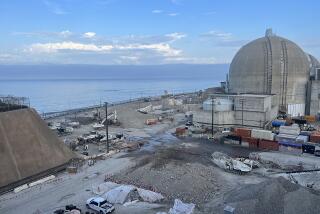Workers enter Japanese reactor for first time since quake
- Share via
Reporting from Sendai and Tokyo — For the first time since the March earthquake and tsunami, workers on Thursday entered the No. 1 reactor at the stricken Fukushima Daiichi nuclear power plant, according to the Tokyo Electric Power Co.
The recovery team began a project to install six ventilation machines that would absorb isotopes from the air inside the building, said company spokesman Taisuke Tomikawa. Due to the high risk of radiation exposure, teams were expected to work in shifts inside the reactor.
The goal is to lower radiation levels so that workers can replace the facility’s cooling systems that were damaged by the tsunami, causing a hydrogen explosion that released damaging radioactivity into the air, soil and water.
In recent weeks, remote-controlled robots have plumbed the depths of the building to test radiation levels, the utility said. In mid-April, a robot recorded radioactivity of about 50 millisieverts per hour inside Unit 1’s reactor building -- a level still too high for workers to enter the structure safely. Subsequent tests have shown a drop in radiation levels.
The devastating temblor and resulting tsunami damaged four of the six reactors at the decades-old facility 140 miles north of Tokyo. Some 80,000 residents have been evacuated from the area around the plant. About 25,000 people along Japan’s northeastern coast have been confirmed dead or are missing after the disaster.
The nuclear-facility workers, organized in teams of twos and threes, are dashing into the reactor for about 10 minutes at a time, in an effort to limit their radiation exposure. They are dressed in full-body protective suits and masks and are lugging 30-pound fire extinguishers in case of an explosion.
The radiation levels inside the reactor are roughly 10 to 40 millisieverts per hour, and work crews are trying to limit their exposure to around 3 millisieverts. U.S. nuclear workers are allowed an upper limit of 50 millisieverts per year. Experts say that a dose of 1,000 millisieverts causes radiation sickness that includes nausea and vomiting.
Tomikawa said it should take two or three days to install the ventilation system. He estimated that the work to install the reactor’s new cooling system could begin as soon as May 16.
Thursday’s development suggests that the utility is making progress in stabilizing the plant. If successfully installed, the cooling equipment would bring down the temperature inside the reactor’s core and speed the process of resolving Japan’s worst nuclear crisis. The company aims to have a cooling system in place by mid-May and will add two more such systems for reactors Nos. 2 and 3 in the next two months.
The system would extract hot water from inside the reactor chamber and inject chilled water into the chamber and the core containing the hot nuclear fuel rods.
Even as work to stabilize the reactors continued, officials announced new findings of radioactive contamination. Tepco said Tuesday that it had found high amounts of radioactive isotopes along the sea floor less than 2 miles off Japan’s northeastern coast. The company said that cesium-134, cesium-137 and iodine-121 turned up in tests performed April 129 in two places at a depth of 65 to 100 feet.
The company said that before the plant began leaking radiation, only trace levels of cesium-137 had been found in the ocean and that the latest readings were more than 600 times higher. Significant levels of cesium-134 or iodine-121 had not been detected previously on the sea floor, Tepco said.
“We continue to monitor radioactivity levels in fish and other sea organisms,” said Tomikawa, adding that the tests will be conducted once a month for the foreseeable future.
The utility said that it had not recorded rising levels of radioactivity in recent tests. “We’re not saying that it’s zero,” Tomikawa said, “but we think we’ve been able to avoid the high radiation levels we had before.”
But radiation levels remain a problem. According to Japanese press reports this week, the nation’s system to predict the volume of radioactive materials emitted in a nuclear accident failed to work as designed because power to the measuring equipment was lost.
Earlier this week, highly radioactive cesium turned up in sewage sludge and slag, a byproduct of incinerated sludge, at treatment facilities in the city of Koriyama, in Fukushima prefecture, according to the Fukushima prefectural government. The amount of cesium was about 1,400 times the levels in the sewage before the quake.
Fukushima officials worry the sewage treatment might contribute to airborne radiation. The government has no guidelines for how to dispose of radioactive sludge, and the slag has been kept in storage facilities. About 500 metric tons of sewage sludge already has been shipped to cement makers, and officials are trying to track where it has gone.
Last month, Tepco said that it hoped to stabilize the facility’s reactors by the beginning of next year. Under a two-phase plan, the company plans to spend three months cooling the reactors and plugging radiation leaks. They also will set up equipment to decontaminate water that was used to cool the reactors and has been pooling in underground tunnels.
During the second phase, which is expected to take about six months, Tepco hopes to put the reactors into a stable state known as a cold shutdown, but deactivating the reactors could take a year to complete.
Glionna reported from Sendai, Japan, and freelance reporter Hall reported from Tokyo.
More to Read
Sign up for Essential California
The most important California stories and recommendations in your inbox every morning.
You may occasionally receive promotional content from the Los Angeles Times.











